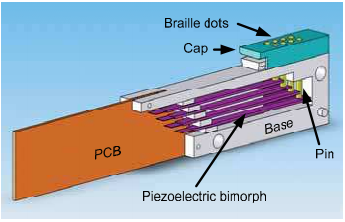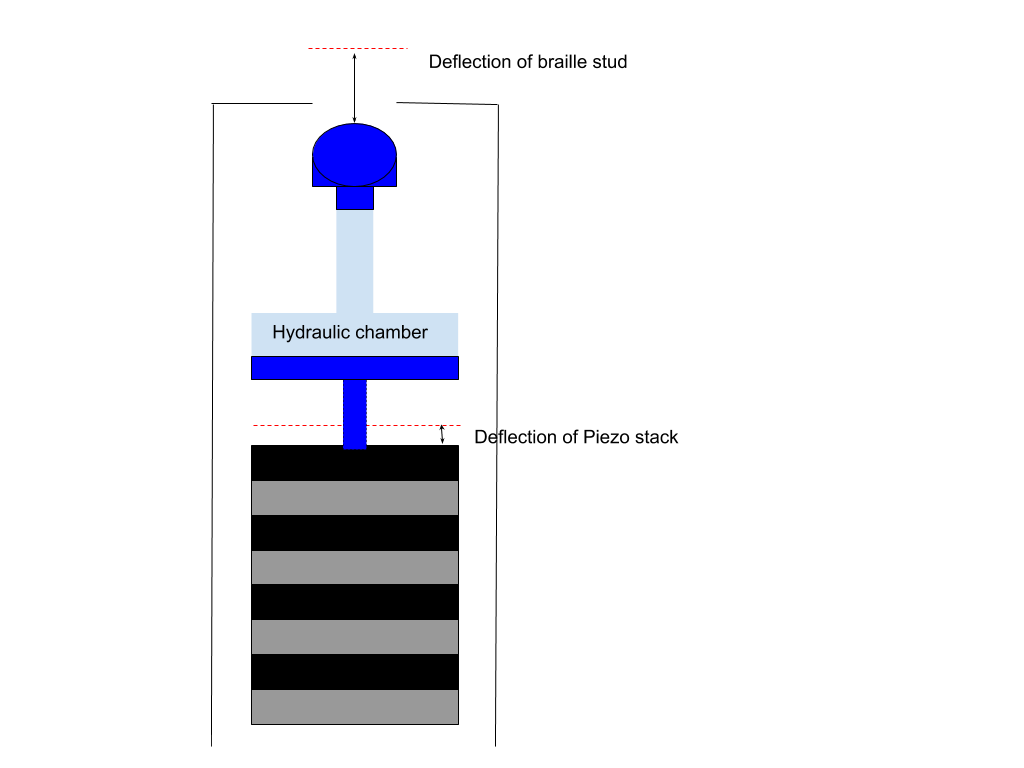Refreshable braille displays
Refreshable braille displays have existed in the market for some time. In some cases, philanthropic organizations fund their R&D costs and purchase them on behalf of blind individuals. Unfortunately, many of the (cheaper) ones can only support one or two lines of braille text, while options that provide an entire page are often very expensive. The one below costs a whopping $3832 (as of July 2020)

So why do these cost so much? Well, lets take a look inside to see how these usually implemented. These displays refresh electronically based on some computer-generated input, so there must be a PCB board attached to a system of actuators which deflect the braille dots. Below is a typical set-up.
Here, a Piezoelectric bimorph is loaded as a cantilever beam, attaching on the fixed end to the PCB and on the deflecting end to a pin. When the beam is loaded with current, it deflects. According to classic solid mechanics, one side of the bimorph will be under tension and the other will be under compression, leading to a vertical displacement on the free side of the beam. As you can see from the image, there are moving components in close proximity which must be manufactured rather precisely. Now the price tag is starting to make sense!
Now, how would one design a full page of braille using this approach? The answer is to use a stair-stepped design consisting of multiple vertical layers of such assemblies, each operating on its own row of braille cells. Leaving aside the expensive R&D and manufacturing cost of such a system, it must be prohibitively expensive to service. You'd need the precision of a Swiss watchmaker to fix a faulty beam!
You may be wondering, if piezoelectrics can change shape with a current, why not simply place a piezo block under each dot and deflect it? The reason this is not possible is that the changes in size are tiny, and it is due to the length of the beam here that makes the overall effect on the braille stud relevant.
Linear actuator
A better approach would a purely linear actuator, where each braille stud would be actuated by a subassembly entirely beneath it. This would make it simpler to manufacture, service, and also would mean that a braille page would be roughly a multiple in cost of a braille line. Of course, I am not the first to imagine this. There is a research project conducted by the University of Michigan to build a microfluidic braille tablet with linear actuators. In their design, the linear actuators are pneumatic, controlled by pressure and the ideal gas law.
Bosch diesel fuel injectors
This may seem like an obtuse change in subject, but please bear with me. I discovered that Robert Bosch Gmbh manufactures diesel fuel injectors with a novel linear actuator based on both piezoelectrics and fluid pressure. This got my attention as I was thinking about the braille reader because the nature of the problem is so similar. Here's a nice video showing how it works.
Essentially, a stack of piezo materials is loaded and deflects by a tiny amount. This tiny amount decreases the volume in a chamber of air. The key innovation here is that the area of the chamber is much larger at the interface with the piezo stack than it is at the interface with the pin. The pin deflection will then be equal to the inverse of this ratio multiplied by the deflection of the piezo stack. Barring the uncooperate behavior of fluids like air in tiny spaces, this means that the deflection of the pin can be as large as needed. What's more, because the assembly is entirely linear, it can be manufactured cheaply on a plane.
Refreshable braille display
Going back to the topic at hand, I am sure you already guessed what I am about to propose.
These cells can be arranged onto a PCB and easily scales to a two-dimension braille reader. I suspect that the manufacturing cost would be low due to the layered design. The global blind population isn't incredibly high so there aren't economics of scale. Fortunately, the price bar is rather low, since products on the market are very expensive.
Going a step further, having a microprocessor on-board with network chips and the ability to load standard ebook formats would turn this into a nifty little device. Perhaps voice commands could be used to tell the book to list the contents of the library, purchase a book, or delete a book can be integrated. I see this as being a potential accessibility platform where the ecosystem of developers, perhaps some of them blind, can contribute to the quality of the end-user product.

